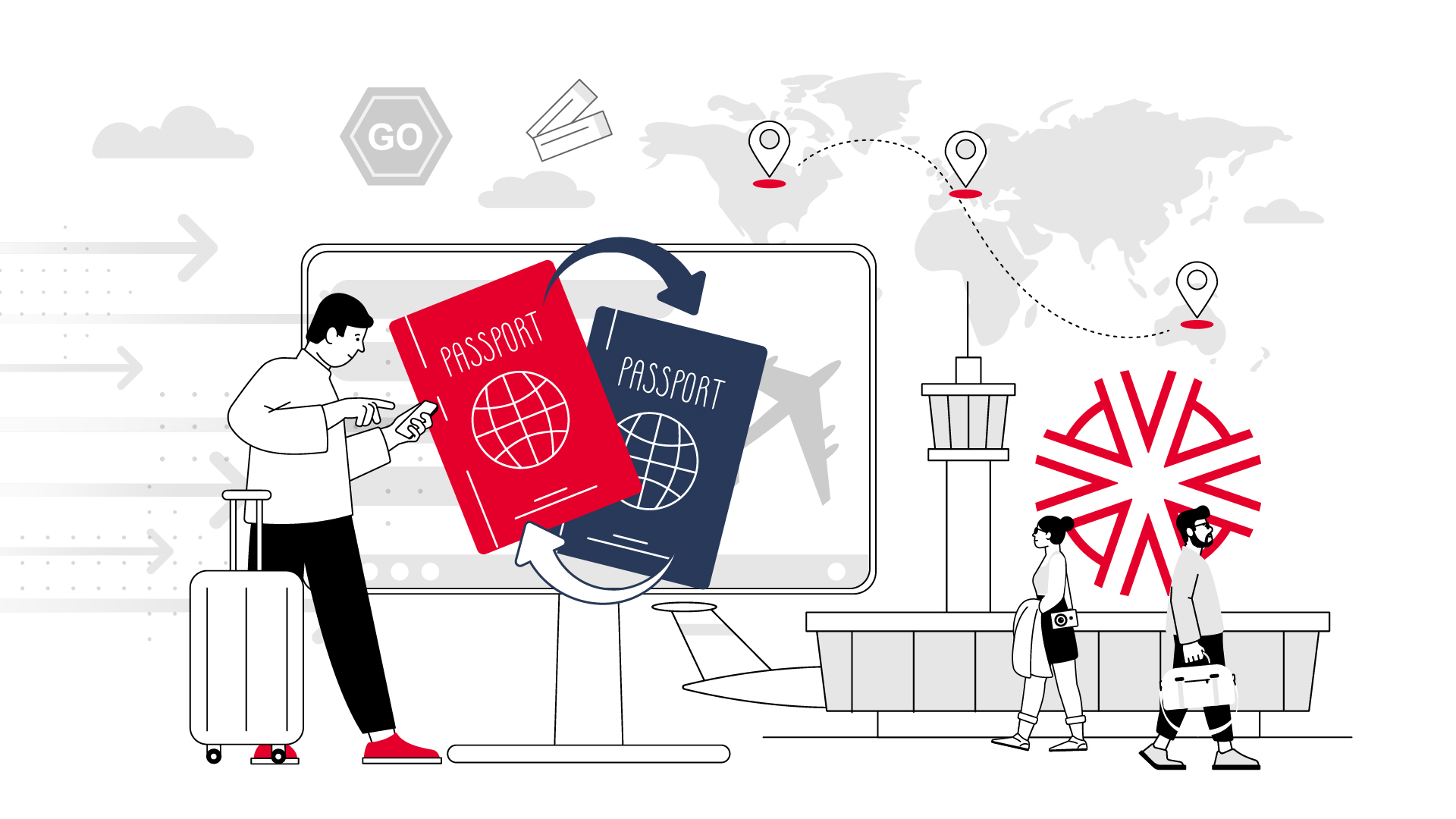Dual citizenship and a second passport are a measure of genuine status in today’s world – and possessing two passports elevates traveling to unparalleled dimensions.
Dual citizenship is as much a tool and resource as a status symbol.
Having a second passport transforms more of the world into a visa-free zone, which by default means fewer government databases into which you need to submit your personal information.
Not to mention enhanced privacy, without needing a visa, you are not informing governments of your travel plans and itinerary.
Being a dual citizen and traveling with two passports unlocks the world while better securing your privacy as you explore it.
But how exactly does a dual citizen travel and use two passports? The experts at Astons are here to explain.
How dual citizens travel with two passports
Having two passports is one of the most significant benefits and advantages of being a dual citizen.
But the question is often asked: how do you travel using two passports?
It’s a great question, and the answer is actually much more straightforward than many expect.
To best understand how to travel using two passports, it is easiest to divide the travel in the following ways:
- The stages of traveling – arrival vs departure
- Where and how you are traveling
The stages of traveling with two passports
Traveling with two passports – the departure process
When traveling with two passports, the most important thing to remember is which one to use when.
It is easy to confuse departure and arrival elements simply because they intersect at the same point – the departure airport.
However, thinking about these elements individually makes it easier to understand how to apply the appropriate passport to each stage.
To begin with, at the departing airport, there are typically three instances in which you need to present a passport – in order:
- At check-in
- At passport control
- At the boarding gate
Situations 1 and 3 are connected to the airline, and thus, by default, the plane ticket and the arrival destination.
Situation 2 is based solely on how you are in the system – specifically, how you entered the country you are departing.
When booking your plane ticket, you need to use the passport you intend to enter the next country with – not the passport you need to show to depart the country you are currently in.
At check-in and the boarding gate, you will show the airline staff the passport you used to book the ticket and intend to use to enter the next country. It is not their business or concern if you have other passports in your possession.
At the departing passport control, you do not need to show them your airline ticket – so you don’t. It is not their business or concern if you have other passports in your possession.
You only need to present the passport you used to enter the country with – and that is precisely what you do.
Once you are finished with departure passport control, you can put that passport away – you will no longer need it.
As a note, some countries require their citizens to depart, enter, or both using that country’s passport if you are a citizen of that country.
For example, all US citizens must use a valid US passport to enter and depart the United States – no exceptions.
Traveling with two passports – the arrival process
The arrival process is straightforward once you arrive in your new country.
Everything at this stage only involves one passport – the one you used to book the ticket with.
You simply depart your plane and head to arrival passport control.
At passport control, present the passport you want to enter the country with – the one that matches the plane ticket – and get entered into the system under that identity.
For the return journey, do the same steps, but the airports are simply reversed.
That is how dual citizens travel using two passports.
Does where or how you travel affect using a second passport?
There is an interesting twist when discussing international travel, as not all international travel is the same.
Where you travel can actually make international traveling more like domestic travel.
For example, once you have entered any EU country that is a member of the Schengen Zone, you can travel internationally to any other EU country of the Schengen Zone without needing a passport or dealing with passport control. This applies to the travel element obviously, to book a plane ticket is the same process and requires the same information.
However, if you travel from an EU country in the Schengen Zone to an EU country outside the Schengen Zone – Cyprus, Ireland, Bulgaria, and Romania – you do need to pass through passport control.
At these points, you need to use the same passport you used to enter the first EU country.
The Schengen Zone is a group of 27 European countries, mostly EU members, that have eliminated border control for travel between themselves.
If a dual US/German citizen entered Germany using their German/EU passport, and during their visit that person decided to travel to Italy, they would not be bothered with passport control.
However, if they were to visit Bulgaria, they would need to deal with border control and show their German passport to enter and leave Bulgaria to return to Germany.
Note – As of 1 April 2024, Bulgaria and Romania officially entered the European Union’s Schengen Zone
Likewise, how you travel can impact using two passports, but only in operation—the arrival and departure elements of which passport to use when remains the same.
For example, if you are traveling across international borders by bus, it is the same procedure as buying an airplane ticket. You must show the same passport for entry and departing the same country.
When crossing borders by bus, the bus ticket is often irrelevant, but to be sure, when travel tickets are involved, always follow the framework outlined in the airport example above.
When crossing by car, no ticket is involved; this is simply a straightforward passport issue. When you reach the departing border, you show the passport you entered that country with.
When you reach the next border, you present the passport with which you want to enter the country.
As a note, vehicle and insurance documentation can complicate this situation – specifically, the vehicle and insurance documents need to match the identity you present at passport control.
To address any discrepancies, you need to speak with the agencies that issued those documents and ask how they address the situation of dual citizens with more than one passport. They may issue duplicate documents with the other identity.
When traveling by ferry or train, implement the airport framework.
Benefits of traveling with a second passport
There is a litany of benefits and advantages to being a dual citizen, but arguably the biggest is having two passports.
While citizenship represents rights, passports represent access, and together, they are status.
With two passports, an entrepreneur, investor, and family can unlock destinations they are currently shuttered from due to visa requirements.
For example, US citizens require a visa to enter Russia, China, and Brazil. However, those with Caribbean passports from Dominica or Grenada can enter those countries visa-free.
A dual citizen of the US and Grenada would wield the power of both citizenships and, by default, both passports.
The Caribbean countries have signed an historic collective agreement to increase investment requirements to at least $200,000 “no later than 30 June 2024”
Also, launching in 2025 is ETIAS, the EU’s eVisa system that will require all third-country nationals – including US, UK, Canadian, and Australian citizens – to apply for approval in order to enter any EU country. All EU citizens and EU residents will have ETIAS exemption.
Likewise, there are situations in which you don’t want some countries to know which places you have visited in the past. By using separate passports, you can shield your travel from unwarranted inspection.
Using two passports can also prevent the country you just left from knowing where you are going.
Pros to traveling with two passports
- Global mobility is genuinely global
- Access more visa-free countries
- Extended length of stay in certain countries
- No residency visa is needed in certain countries
- Use as identity documents to open bank accounts
- Prevent your travels from being tracked by unscrupulous parties and apps
- Use as an identity document to access education and health institutions in certain countries
- Access business grants and incentives in certain countries
- Work in certain countries as a citizen or resident without any visa requirements
- Privacy at a level unattainable any other way
Cons to traveling with two passports
- Cannot purchase round-trip tickets
- Passport management – get confused about which passport to use when
- Passport renewals – some countries require submitting biometrics in person
- Picking a favorite
How to become a dual citizen and get a second passport
Being a dual citizen is accessing a degree of self-sovereignty that was once only available to monarchs and the elite.
Today, however, this freedom and power move is available to entrepreneurs, investors, and families worldwide.
Astons provides access to a portfolio of citizenship and residency solutions that provide direct access to dual citizenship or Golden Visa programs that can lead to citizenship eligibility.
Our most popular programs are in the European Union and the Caribbean, and most can be completed in less than a year.
Which is best for you depends upon your wants, dreams, goals, and demands, but our team will create a list of solutions for you to choose from that addresses them all.
Schedule your Free Confidential and Comprehensive Consultation with an expert at Astons now.














